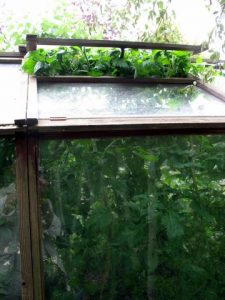We are approaching the time of the season when we’ll decide how many tomato trusses to allow on our tall varieties, and when to pinch out the growing tips.
A rough guide is:
- Four trusses for plants grown outdoors
- Five or six trusses for plants in a greenhouse or polytunnel
However, before we pinch out the growing tips, we need to take into account a number of things such as …
- The size of the fruit (cherry, medium or beefsteak)
- The earliness – days to maturity – of the plants
- The likely weather conditions
- How long ’till the end of the season
- If the plants are growing out through the greenhouse roof!
From flowers to fruit
From flowers that have just set to mature fruit takes between two to three months, depending on the variety and growing conditions. So if we have reasonable weather up to the end of September, we should hope to see the highest trusses begin to set around the end of July.
Quick to mature
Cherry varieties will almost always mature more quickly than larger varieties because they have less growing to do.
The weather
The weather obviously plays its part in how quickly tomatoes grow and the “cut-off point” when temperatures drop in the autumn and plants stop growing.
If you are growing outside, you can always remove the unripe trusses at the end of the season and ripen them inside.
The longer your growing season, the more trusses you can grow before you pinch out the growing tips, assuming that you have a tall enough greenhouse! Thanks to Ted S. for the photo.
It’s good to remember … a plant that has fewer trusses will usually produce ripe tomatoes sooner than one that has more trusses.
Flowers setting fruit – some plants are “fussy setters”
Two examples – both are bush varieties.
Tumbling Tom
I always grow this variety but it is a fussy setter and requires better conditions for flower set than many other varieties.
However, it is very productive when it gets going and its tasty tomatoes have a good shelf life, although they probably won’t need it because they’ll soon be eaten!
Another great quality about Tumbling Tom is that it can be started off early in the season without becoming “leggy”, so it is usually the first variety I sow each season.
Red Alert
I have to say that this is my favourite variety – very productive with arguably one of the best tastes of any cherry variety. It sets very easily (unlike Tumbling Tom) but its disadvantage is that it becomes very leggy when started early in the season when there is not enough light.
Blossom Drop
This happens because flowers fail to set (pollinate) and can have a devastating effect when a whole truss fails to set.
Encourage flower to pollinate
To encourage pollen movement around the inside of the flower – tomato flowers are self-pollinating – tapping plants can help and also using something that vibrates such as an electric toothbrush held against the flowers that simulates the vibration of bees. As one newsletter reader put it … “is that an Oral Bee?”
Here’s a video that I made a few seasons ago. It contains pinching out the growing tip of plants and an electric oral bee!
Later in the video you will see the use of side shoots as cuttings.
Using side shoots as cuttings
However, taking cuttings mid-season isn’t worth it if you live in a short season area. There won’t be enough time for the plants and fruit to mature before the temperatures drop in the autumn.
There is a method of taking small cuttings and over-wintering them indoors. This produces a very early crop in the Spring – more about this in a later newsletter.
Regards,
Nick

